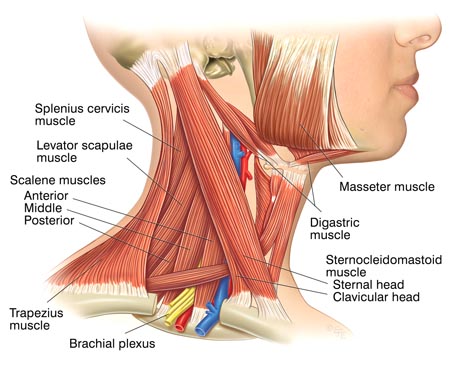Neck pain – a most common complaint is also known as cervicalgia. The neck consists of seven vertebrae (sections). These are interlocking bones, separated by disks, that enable movement and stability. The neck is less protected than the rest of the spine. For this reason, it may be more prone to injury or conditions that cause pain. Neck muscles can be strained from poor posture — whether it’s leaning over your computer or hunching over your workbench.
Neck Structure:
The head is supported by the lower neck and upper back, and it is these areas that commonly cause neck pain. The top three joints in the neck allow for most movement of the neck and head. The lower joints in the neck and those of the upper back create a supportive structure for the head to sit on. If this support system is affected adversely, then the muscles in the area will tighten, leading to neck pain.
Ignoring neck pain can be a symptom of a more serious problem. By clearly describing your specific neck symptom, or combination of symptoms, you can help your doctor determine what’s wrong. To help you to diagnose and understand we give you the common symptoms which will be helpful for you.


Symptoms of neck pain:
Symptoms associated with neck pain can be:
- Pain that’s often worsened by holding your head in one place for long periods, such as when driving or working at a computer.
- Arm numbness or tingling
- Headaches
- Shoulder pain
- Sharp shooting pains or a dull ache in your neck
- Trouble with gripping or lifting the objects
- Neck swelling
- Cervical Radiculopathy (Problems with reflexes, sensation or strength)
- Muscle tightness and spasms
- Decreased ability to move your head
- Headache
- Neck nerve and bone pain
When to see your doctor:
If symptoms persist for more than a week, consult with your doctor. You should also see a doctor if you have:
- fever
- swollen glands
- severe neck pain without apparent cause
- lump in your neck
- headache
- nausea
- vomiting
- trouble swallowing or breathing
- weakness
- numbness
- tingling
- pain that radiates down your arms or legs
- inability to move your arms or hands
- inability to touch your chin to your chest
- bladder or bowel dysfunction
If you’ve been in an accident or fall and your neck hurts, seek medical care immediately.
Causes:
Your neck is flexible and supports the weight of your head, so it can be vulnerable to injuries and conditions that cause pain and restrict motion. Neck pain causes include:
- Muscle strains.
Overuse, such as too many hours hunched over your computer or smartphone, often triggers muscle strains. Even minor things, such as reading in bed or gritting your teeth, can strain neck muscles. Poor posture, sleeping with you neck in a bad position, jerking your neck during exercise. Continuous use of mobile bending your neck downwards. Using wrong mattress, sleeping position, overall lifestyle and food habits.
- Worn joints.
Just like the other joints in your body, your neck joints tend to wear down with age. Osteoarthritis causes the cushions (cartilage) between your bones (vertebrae) to deteriorate. Your body then forms bone spurs that affect joint motion and cause pain.
- Nerve compression.
Herniated disks or bone spurs in the vertebrae of your neck can press on the nerves branching out from the spinal cord.
- Injuries.
Rear-end auto collisions often result in whiplash injury, which occurs when the head is jerked backward and then forward, straining the soft tissues of the neck.
Injuries can be further classified in detail to know the exact treatment.
Neck Injury Can Damage Soft Tissue & Bone:
The most common type of cervical spine injury comes in the form of a sudden movement or impact that overstretches or severely twists the neck. The bones (vertebrae) in the cervical spine are connected by neck muscles, nerves, and ligaments. Each vertebra is cushioned along the spine by discs that absorb any pressure or impact.
Neck pain can easily result from such injuries as:
- Whiplash
- Burners and Stingers
- Cervical Fracture (Broken Neck)
- Cervical Radiculopathy (Pinched Nerve)
- Concussion
- Falls
- Contact sports
- Repetitive motion stress
Damaged tissue that irritates nerves surrounding the cervical spine, leading to what many refer to as a “pinched” nerve. The orthopaedic term is cervical radiculopathy. Hard impact from a sports injury or a fall may result in strained neck muscles or painful compression along the spinal column in the neck area.
In severe cases, neck injury goes beyond soft tissue damage and may involve fractured or dislocated bones in the spine. In addition to neck pain, these types of neck injuries may lead to serious complications such as paralysis.
Spine care specialists typically warn patients to seek immediate care when neck pain also involves radiating pain or numbness in the legs or arms. Be particularly aware of neck pain accompanied by headaches, numbness, tingling
or weakness.
Diseases and Conditions linked with neck pain:
Medical disorders linked to neck pain can result in severe, chronic pain and long-term disability in some cases. Orthopaedic spine doctors are specially trained and experienced in treating neck disorders such as:
- Osteoarthritis or rheumatoid arthritis
- Congenital torticollis (twisted neck)
- Spondylosis (cervical disc degeneration)
- Degenerative disc disease
- Herniated disc
- Tumours or Cancer
- Meningitis (Infection)
To pinpoint the cause of your neck pain, find an experienced orthopaedic specialist, spine doctor, or spine surgeon. At Agile Ortho, the goal is to present patients with the most comprehensive choice of options.
